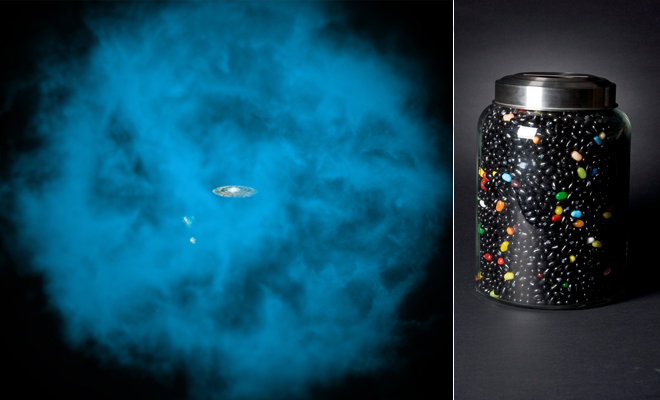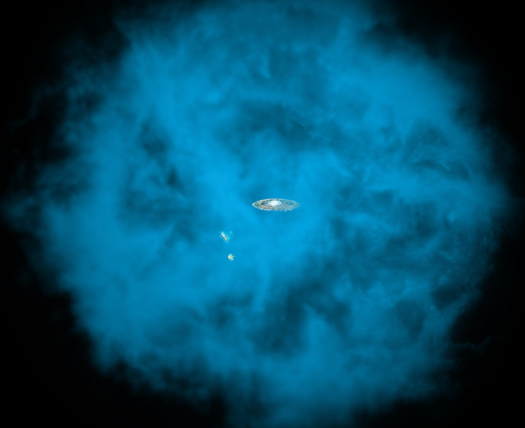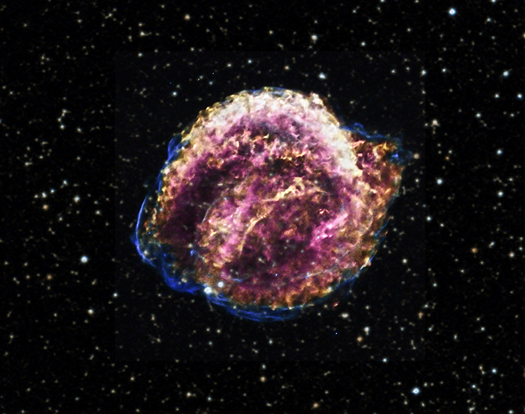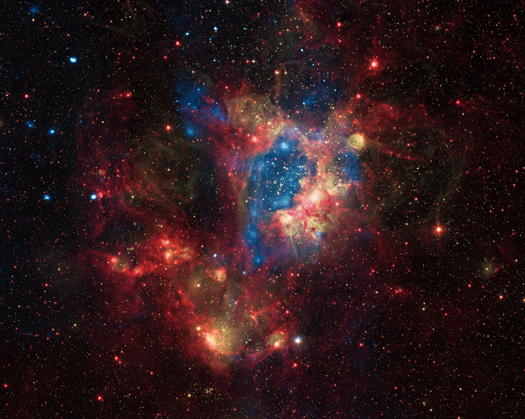Answering Two Popular Questions About That Hot Gas

In writing a press release, a major goal is to present the truth, and nothing but the truth. However, it isn't practical to present the whole truth. For example, the paper associated with our press release last week was only six pages long, but contained 38 references to other papers, and each of these papers contain many more references. This is how research advances, building incrementally on previous work. Since we have limited space in a press release we cannot present the whole truth and we only include the information that we think is crucial for explaining the result and its significance.
Milky Way is Surrounded by Huge Halo of Hot Gas
This artist's illustration shows an enormous halo of hot gas (in blue) around the Milky Way galaxy. Also shown, to the lower left of the Milky Way, are the Small and Large Magellanic Clouds, two small neighboring galaxies (roll your mouse over the image for labels). The halo of gas is shown with a radius of about 300,000 light years, although it may extend significantly further.
A Space Jigsaw Puzzle: Coordinating Chandra With Other Telescopes
In July 2012, an event took place that gives us a chance to talk about several important aspects of Chandra observations involving coordination with other observatories, how they are done, and how they fit into the bigger picture of astronomical research.

Coordinated observations are those that must be done by Chandra and one or more other observatories at approximately the same time. Astronomers often want to study objects with multiple observatories because their different capabilities --- especially in detecting different regions of the electromagnetic spectrum --- can provide insight that no single observatory can do alone. The need for coordination in time comes because so many objects in space vary over time. That means that observations taken too far apart could be less valuable because the object has changed substantially in the meantime. It's often important for all observatories involved to catch the object during a particular celestial event. In the current annual cycle, Chandra's 13th , for example, about 10% of the approved observations request coordination with another observatory.
Was Kepler's Supernova Unusually Powerful?
In 1604, a new star appeared in the night sky that was much brighter than Jupiter and dimmed over several weeks. This event was witnessed by sky watchers including the famous astronomer Johannes Kepler. Centuries later, the debris from this exploded star is known as the Kepler supernova remnant.
Astronomers have long studied the Kepler supernova remnant and tried to determine exactly what happened when the star exploded to create it. New analysis of a long observation from NASA's Chandra X-ray Observatory is providing more clues. This analysis suggests that the supernova explosion was not only more powerful, but might have also occurred at a greater distance, than previously thought.
Going Back to School
This week marks the return to school for most kids (if they haven't been there for a week or more already). The post-Labor Day week got us thinking about school and education as it relates to Chandra and X-ray astrophysics.

A Surprisingly Bright Superbubble
This composite image shows a superbubble in the Large Magellanic Cloud (LMC), a small satellite galaxy of the Milky Way, located about 160,000 light years from Earth. Many new stars, some of them very massive, are forming in the star cluster NGC 1929, which is embedded in the nebula N44. The massive stars produce intense radiation, expel matter at high speeds, and race through their evolution to explode as supernovas. The winds and supernova shock waves carve out huge cavities called superbubbles in the surrounding gas. X-rays from NASA's Chandra X-ray Observatory (blue) show hot regions created by these winds and shocks, while infrared data from NASA's Spitzer Space Telescope (red) outline where the dust and cooler gas are found. The optical light from the 2.2m Max-Planck-ESO telescope (yellow) in Chile shows where ultraviolet radiation from hot, young stars is causing gas in the nebula to glow.
"Here, There, and Everywhere" Makes its Debut
Today marks the launch of a new project – both physically and virtually. We are so happy to announce that "Here, There, and Everywhere" (known by the acronym of HTE) has officially debuted.
You may have heard this question, or asked it yourself: why bother studying things that are millions or billions of miles away in space? HTE, among other things, is a project that addresses that question.
Remembering the Original Chandra
On August 21, 1995, the field of astrophysics lost one of its greats. Seventeen years ago this week, Subrahmanyan Chandrasekhar passed away. Chandra, as he was known to his friends and colleagues, was widely regarded as one of the foremost astrophysicists of the 20th century.
Q&A with Michael McDonald
Astrophysics and the Olympics
It's not every day that we can mention "Chandra" and the "Olympics" in the same sentence, but today we can. That's because Stacie Powell, who will compete in the 10-meter platform diving competition for Great Britain at the London Olympics beginning today, is also working on her Ph.D. in astrophysics.




